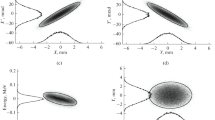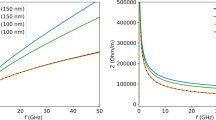Summary
The space-charge-induced crossing of half-integer and integer stop bands is examined for storage rings proposed to drive inertial-confinement fusion. Two different approaches are used: a classical resonance crossing picture and a diffusion model based on the addition of kicks due to field errorw with phase randomization due to rapidly changing tune shifts. Gradient and bending field tolerances to permit crossing of stop bands with acceptable emittance growth are established and compared to those observed in existing machines like the CERN-PS. Two different situations are to be distinguished in driver rings: the «stacking plus holding» period (of 5–50 ms) during which the rings are filled and the final bunching (during 10–50 μs) when the bunches are compressed from typically 100 to 10 ns length prior to extraction into the final transport system. Gradient tolerances to permit stop band crossing are found to be Δ(kl)/kl≤10−4 per quadrupole during stacking and ≤5·10−3 during final bunching; compared to a few 10−3 observed in the PS. Tolerances to survive resonances driven by bending field errors are Δ(Bl)/Bρ≤5·10−6 per element even in the final bunching period; an order of magnitude smaller than «typical» uncompensated values in the PS. Stop bands driven by gradient and bending field errors are affected by the «incoherent» and the «coherent» tuneshifts respectively. Hence for the driver rings one may contemplate working with a large incoherent tuneshift (ΔQ ic≤5) during final bunching but keeping the coherent detuning (during stacking and bunching) and the incoherent detuning during stacking small enough (ΔQ≤0.5) to avoid resonances in these conditions. The more conservative approach to avoid gradient error resonances even during final bunching leads to difficult constraints for other parameters. Experiments on the PS to test fast resonance crossing are also briefly discussed.
Similar content being viewed by others
References
J. J. Laslett:On intensity limitations imposed by transverse space charge effects, inProceedings of the 1963 Summer Study on Storage Rings, Brookhaven Nat. Lab., Report BNL 7534 1963, p. 324;L. J. Laslett andL. Resegotti:The space charge limit imposed by coherent oscillation, inProceedings of the VI International Accelerator Conference, Cambridge, USA, 1967 (Report CEAL 2000), p. 150.
C. Rubbia:On heavy ion accelerators for inertial confinement fusion, inProceedings of the IAEATechnical Committee Meeting on Drivers for Inertial Confinement Fusion, Osaka, Japan, April 1991, p. 74.
D. Möhl:Transverse space-charge effects in heavg ion storage rings, CERN internal Report PS/AR Note 91-04, 1991.
A. G. Ruggiero:Consideration on the use of synchrotron for the heavy ion fusion project, inProceedings of the Heavy-Ion Fusion Workshop, Brookhaven National Laboratory, 1977, BNL-Report 50769, p. 10.
I. Hofmann:Part. Accel.,39, 169 (1992).
E. D. Courant andH. S. Snyder:Ann. Phys.,3, 1 (1958).
A. Schoch:Theory of non-linear perturbations of betatron oscillations, CERN Report 57-21, 1957.
L. Thorndahl andD. Möhl:Crossing of half-integer stop bands: an experimental study performed on the CPS, CERN internal Report ISR-300/Li/GS/69-20, 1969.
K. Schindl:Compensation of 2Q v=11in four PSBrings, CERN internal Report PS/BR Note 82-2, 1982;G. Gelato, L. Magnani, N. Rasmussen, K. Schindl andH. Schönauer:Progress in space-charge limited machines: four times the design intensity in the CERNproton synchrotron booster, inProceedings of the 1987 IEEE Particle Accelerator Conference, Washington, p. 1298.
D. Möhl:Intensity limitations in the present and future PS, CERN internal Report MPS-DL-Note 72-6, 1972.
K. Schindl andE. Troianov:Experiments on third-order resonances in the PSB, CERN internal Report PS-BR/78-16, 1978.
D. Möhl:Transverse blow-up due to synchrotron oscillations in an intense charged beam, inProceedings of the VI International Accelerator Conference, Cambridge, USA, 1967 (Report CEAL 2000), p. 478.
Y. Baconnier:Tune shifts and stop bands at injection in the CERNproton synchrotron, CERN internal Report PS/87-89 (PSR), 1987.
C. Bovet, R. Gouiran, I. Gumowski andK. H. Reich:A selection of formulae and data useful for the design of A. G. synchrotrons, CERN internal Report MPS-SI/Int. DL/70-4, 1970.
R. Cappi, R. Garoby, D. Möhl andJ. L. Vallet:Beam behaviour under very strong space-charge conditions, CERN internal Note, to be published.
P. Lefèvre:Mesure très peu déstructive des distributions transversales dans le PS, CERN internal Report PS/DL Note 78-8, 1978;C. Steinbach andM. Van Rooij:A scanning wire beam profile monitor, inProceedings of the 1985 IEEE Particle Accelerator Conference, Vancouver, p. 1920.
R. Cappi, R. Garoby, S. Hancock, M. Martini andJ. P. Riunaud:Measurement and reduction of tranverse emittance blow-up induced by space charge effects, inProceedings of the 1993 Particle Accelerator Conference, Washington, to be published.
Author information
Authors and Affiliations
Rights and permissions
About this article
Cite this article
Möhl, D. Transverse space-charge effects in heavy-ion storage rings for intertial-confinement fusion. Nuov Cim A 106, 1687–1695 (1993). https://doi.org/10.1007/BF02821268
Received:
Accepted:
Published:
Issue Date:
DOI: https://doi.org/10.1007/BF02821268




